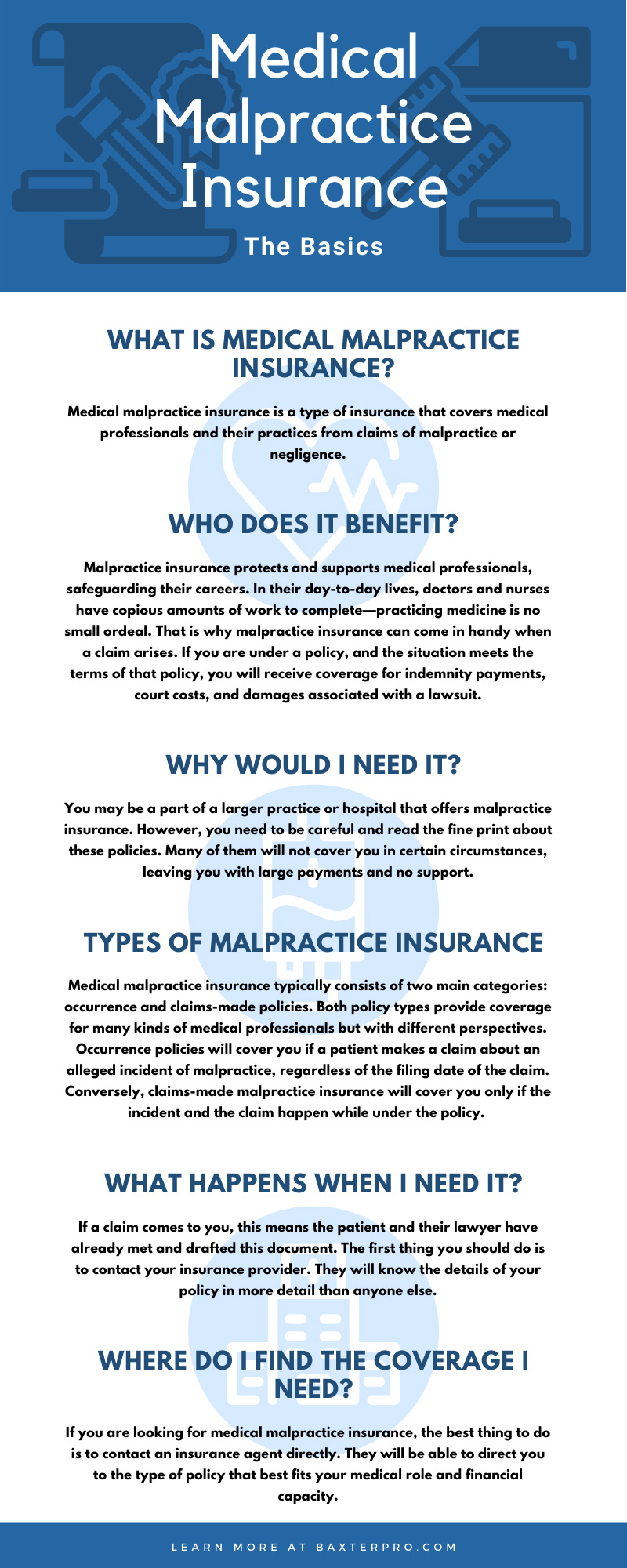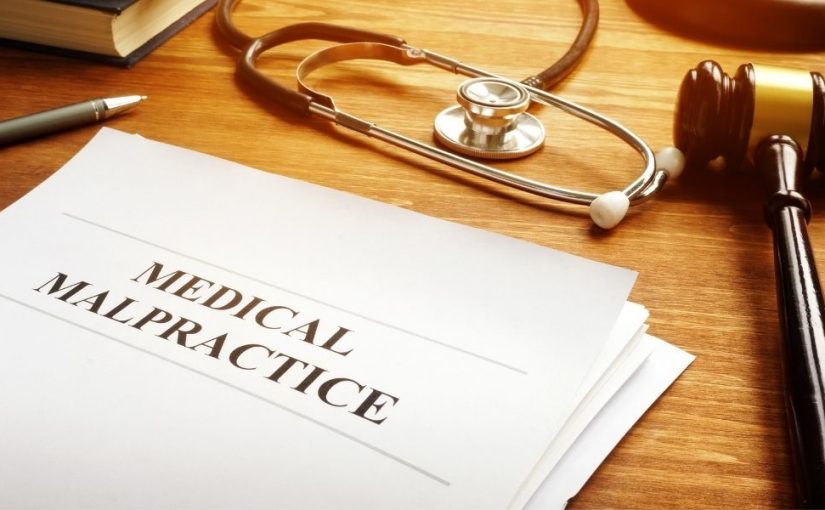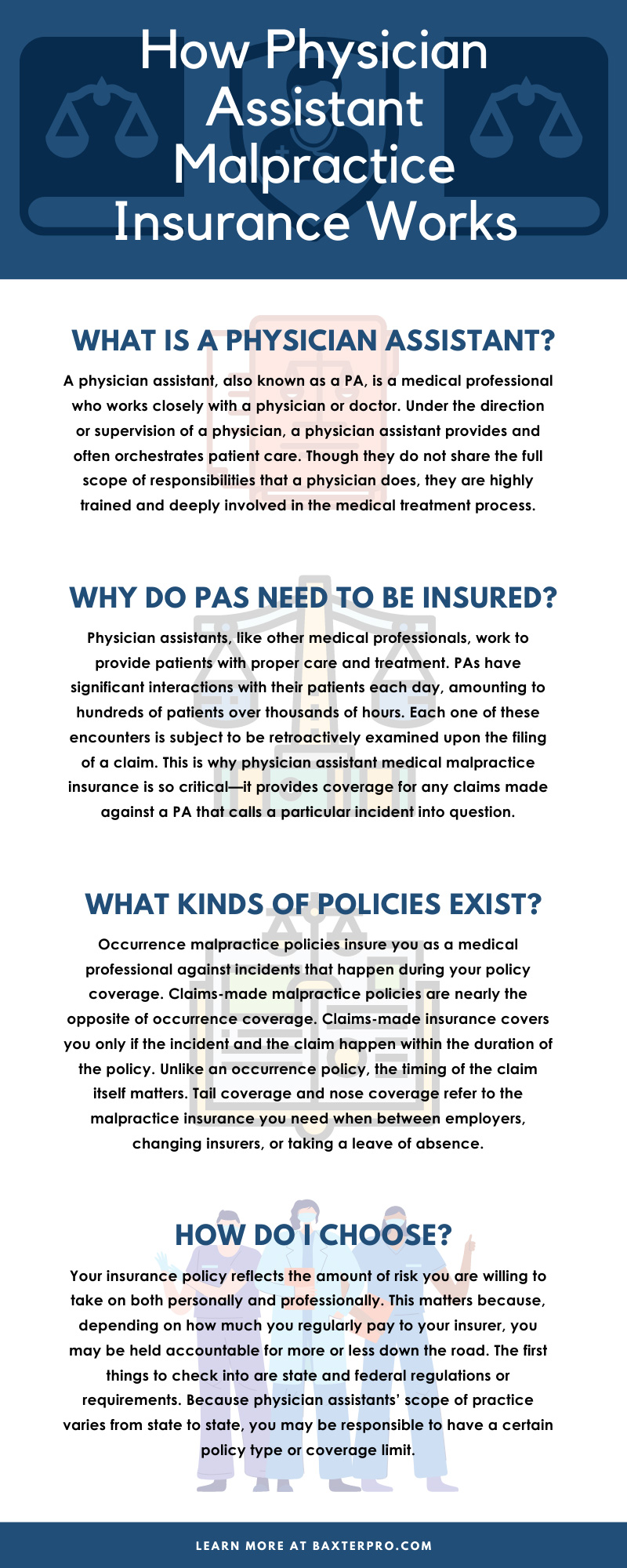The best thing to do when it comes to medical malpractice insurance is to conduct thorough research. Every question has an answer with a little help and digging. To start your journey into the insurance world, here is medical malpractice insurance: the basics.
What Is Medical Malpractice Insurance?
Medical malpractice insurance for healthcare professionals is a type of insurance that covers medical professionals and their practices from claims of malpractice or negligence. It is no secret that practicing medicine involves artful interpretation and application. In most cases, medical professionals have extensive training and are capable of collecting information, making diagnoses, crafting treatments, writing prescriptions, and generally practicing medicine. But there are many places in the medical process where something can go wrong. Patients are able to file a claim of malpractice or negligence against their care providers under a variety of circumstances, and this is where malpractice insurance comes in.
Who Does It Benefit?
Malpractice insurance protects and supports medical professionals, safeguarding their careers. In their day-to-day lives, doctors and nurses have copious amounts of work to complete—practicing medicine is no small ordeal. That is why malpractice insurance can come in handy when a claim arises. If you are under a policy, and the situation meets the terms of that policy, you will receive coverage for indemnity payments, court costs, and damages associated with a lawsuit. By having the financial side of the equation taken care of, you can focus on the other problems at hand.
Why Would I Need It?
You may be a part of a larger practice or hospital that offers malpractice insurance. However, you need to be careful and read the fine print about these policies. Many of them will not cover you in certain circumstances, leaving you with large payments and no support. That is why securing your own malpractice insurance can save you from the headaches of pecuniary burdens. If you have questions about what kind of policy you need, reach out to one of our insurance professionals here at Baxter & Associates.
Also, consider talking with a trusted friend or fellow medical professional—they may be able to offer personal insights into malpractice insurance. When it comes to malpractice insurance, the simple answer is this: you have nothing to gain and everything to lose by not covering your risk. Furthermore, the majority of insurance agencies have insurance agent errors and omissions insurance, which protects them from further fallout. By having this double-backed system of insurance, you will be more than ready to handle whatever comes your way.
Types of Malpractice Insurance
Medical malpractice insurance typically consists of two main categories: occurrence and claims-made policies. Both policy types provide coverage for many kinds of medical professionals but with different perspectives. Occurrence policies will cover you if a patient makes a claim about an alleged incident of malpractice, regardless of the filing date of the claim. The great part about occurrence policies is that you will receive coverage for claims made against you even after your policy has expired. For example, if a patient files a claim in June of 2020 for an incident that took place in March, but your policy expired in May of 2020, you will still receive coverage. Because the incident in question happened while you were paying for the policy, the insurance will still be in effect.
Conversely, claims-made malpractice insurance will cover you only if the incident and the claim happen while under the policy. If we look at the above example, the incident took place while under the policy, but the claim’s filing date was afterward. Under claims-made malpractice insurance, because one of those actions occurred while you weren’t paying for the policy, you will not receive coverage.
Another part of medical malpractice insurance is tail or nose insurance. These are policy add-ons that provide coverage while you are in transition. If you are moving jobs, changing insurers, or taking a leave of absence, you may need to update your policy to ensure continual coverage. On the one hand, tail coverage is added onto the end of your current policy—hence the name “tail.” On the other hand, nose coverage is attached to the beginning of your new policy. In both cases, you are simply covering all your bases so that there are no gaps in your protection.
What Happens When I Need It?
As a medical professional, you focus on healing people and ameliorating their pain. However, there are times when a claim comes against you, and you need help. If a claim comes to you, this means the patient and their lawyer have already met and drafted this document. The first thing you should do is to contact your insurance provider. They will know the details of your policy in more detail than anyone else. Even if they are not able to take any action at that point, alerting them to the situation and maintaining a clear line of communication is important. Your insurer should also be able to recommend your next steps, which will likely include consulting with a lawyer and making contact with all parties involved.
Where Do I Find the Coverage I Need?
If you are looking for medical malpractice insurance, the best thing to do is to contact an insurance agent directly. They will be able to direct you to the type of policy that best fits your medical role and financial capacity. Before you interact with an insurance professional, have a few things prepared. Set a budget, and know roughly what amount you can pay for insurance. Do research ahead of time to understand what the standard payment amount is for your role and location. Because insurance requirements and costs differ by state, seeing where you fit into the grand scheme of things is necessary. Also, ask the insurance agent about their agency’s experience supporting clients when claims arise. Inquiring about their track record will help you get a better picture of what happens and if they are competent to handle your insurance. If you have any questions about medical malpractice insurance, contact us at Baxter & Associates to find a policy that works for you.
Learning the basics of medical malpractice insurance can prepare you for a long and successful career in medicine. Get the right coverage and protect yourself from unnecessary harm so that you can offer consistently high-quality care without extra burdens.









